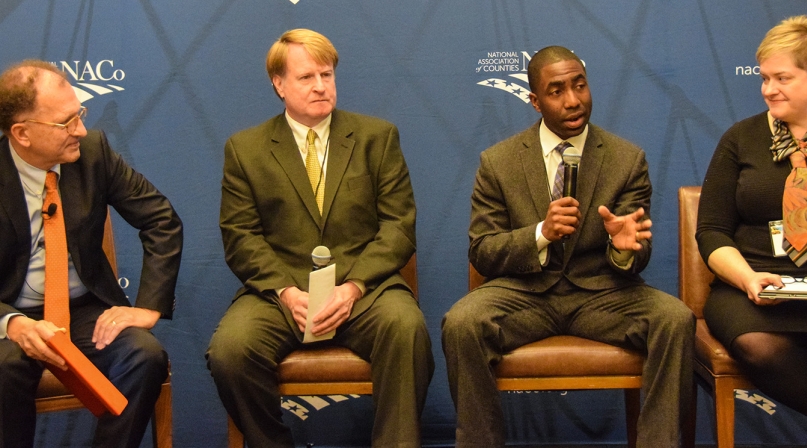Rust Belt communities have the tools and the talent for second acts

Infrastructure, educational institutions, workforce leave Rust Belt counties poised for rebound
For 100 years, Allegheny County, Pa. exported steel.
“Then, for 30 years, we exported young people,” joked Rich Fitzgerald, the county’s executive, about the population drain starting in the 1980s.
In the last few years, though, the Western Pennsylvania region found out that the assets that made it a powerhouse in one era did not necessarily go out of fashion. They just needed some alterations.
“Andrew Carnegie’s mills sent steel all over the country, and he also founded Carnegie Tech,” which is now Carnegie Mellon University, Fitzgerald said at a NACo Large Urban County Caucus symposium in New York City. “That may have a bigger impact on that world in the coming decades than the steel ever did.”
That’s about what Antoine van Agtmael said during a panel discussion on the reemergence of rust belt regions. The senior advisor at the management consulting firm Garten Rothkop diagrammed how these cities and counties were poised for rebounds, diagraming the economic trends that would spur their rebound and showing how closely Pittsburgh’s bio-medical and high-tech sectors mirrored those trends.
Van Agtmael moderated a panel on the reemergence of manufacturing centers. Typically, van Agtmael sees, regions face life-threatening situations, like the decimation of an industry. They respond by calling on their educational systems to help apply a multi-disciplinary approach to solving complex challenges, relying on their research, while being open to sharing brainpower, with the support of local officials.
“If you don’t have a university in your town or a short distance away, it’s a lot more difficult,” he warned. Not just because startups form nearby, but also because of the curiosity that the proximity will inspire in students and faculty.
Rebounding from downturn starts with proper framing of the problems that contributed.
“It’s too easy to just blame China,” he said, for the loss of manufacturing jobs. “Where were these jobs lost? Were they lost because they moved or because the job functions were automated? The fact that we lost some jobs to China actually strengthened our economic immune system, and now we’re starting to do something about it.”
After 25 years of fighting to make products as cheaply as possible, the global competition is starting to revolve around smart innovation. That often revolves around the universities and infrastructure that initially grew out of the first manufacturing boom.
“Is this happening in Silicon Valley or Cambridge, Mass.? No, this is happening all over the country,” van Agtmael said. “Rust belts are building on forgotten strengths and they’re turning themselves into brain belts.”
Like Allegheny County, with its 100,000 students and eight universities, DeKalb County, Ga. has a wealth of educational institutions. Although not part of the traditional Rust Belt, Interim CEO Lee May said the Atlanta region was seeing a similar population and manufacturing shift — particularly in automotive assembly — that demanded a focused response.
“We lacked the plan and vision,” he said. “We didn’t know what assets we had or how to use them.” Georgia Tech conducted a study and inventory of DeKalb County’s industrial vacancies that identified targets for May and the county to fill.
Universities can come in for some criticism. “A lot of people don’t like universities because the students drink a little bit and the schools don’t pay taxes, but they’re economic generators,” Fitzgerald said.
And that’s not just the case for four-year colleges and research universities. Panel speakers stressed that community colleges — and the county governments that oversee some of those schools — need to have good relationships with local industry to streamline course offerings to satisfy demand for the worker training they offer.
“I hear from our local industry leaders that they can’t hire CNC (computer numerical control machine) operators fast enough,” said Heather Worthington, Ramsey County, Minn.’s deputy county manager for economic growth and community investment. “I need more and you [community colleges] need to crank them out faster.”
At the same time, Fitzergald said the demand for welding in advance of a Shell chemical plant is such that the Community College of Allegheny County had to add midnight welding classes and has begun teaching classes at work sites.
He said the county integrates industry leaders and college presidents into planning processes.
“When I was interviewing airport directors, I had the University of Pittsburgh chancellor involved in the interview process,” he said.
Worthington said adjunct faculty from local employers help bridge the gap with students and accelerate the hiring process.
“We basically embed our industries in the classes,” she said.
Because schools built up in response to the initial economic growth, the institutional knowledge related to the earlier industry is a great jumping off point to new innovation. Van Agtmael noted that Summit County, Ohio was the place to go for tires, now the Akron area is a leader in polymer research.
That said, some of these transformations don’t happen fast enough to reassure the people whose jobs are lost either by automation or because manufacturers move.
“There are a lot of people in the Rust Belt who feel left behind by the economy,” Worthington said. “That was clear in the election.”
Van Agtmael warned against reacting with protectionism, which he said would ultimately condition the workforce to accept mediocrity.
“Protectionism is a form of laziness. Would you tell your children it’s okay to be second best, I’ll protect you,” he said. “That goes for sports, business or academics.”
In absence of protectionism in the steel industry, Fitzgerald saw Allegheny County’s workforce transform dramatically.
“In the ’80s, we had the least-college-educated workforce in the 25–35 age range,” he said. “Thirty years later, we lead the nation with more postgrad degrees per capita.”
It’s easy to see that translate to success as a testing ground for driverless cars and medical research, but it was hard to see happening at the time.
“We had been beaten down so long that when it started to turn around, our own people didn’t think it was going to last.”
Attachments
Related News

LUCC members discuss importance of urban transit
Following low ridership during and after the COVID-19 pandemic, investing in urban county transit systems is essential, now more than ever, to cultivate thriving communities, LUCC members said.

Ongoing support is crucial for counties tackling overdose rates
The best treatment option for polysubstance use is “contingency management,” which is when someone with substance use disorder is given an incentive, such as money, for not using.

Proposed federal mandates cloud opioid treatment
Counties are positioned to quickly feel the effects of Office of National Drug Control Policy’s new priorities.
